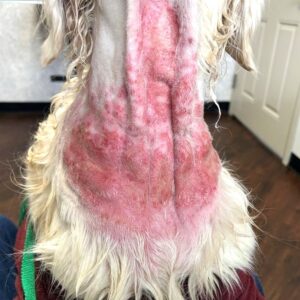Laser Spotlight on Hot-spots/Pyotraumatic /Acute Moist Dermatitis.
Image courtesy of Dr Amy Schnedeker.
The opinions expressed here below are solely those of Vets1laser.com and not attributable to any other individual.
The ever-increasing emphasis on the need to minimize antibiotics use to guard against disturbance of the balance of the skin microbiome-let alone with the global class actions now being brought against manufacturers of certain classes of antimicrobials for humans- means owners are becoming far less likely to comply with administering any antibiotics to their pets. Therefore, we as vets need to do as much as we can initially with these cases in the clinic so as to set the owner and the pet up for success at home.
I am always a big believer in good old-fashioned ‘elbow-grease’: of getting in and shaving and debriding and cleaning up these ‘hot-spot’ areas before starting any pharmacy. Too many dogs present as repeat sufferers that had no prevention nor proper decontamination done on earlier episodes, leaving their owners expecting their pet would go home on some heavy-duty medications for a protracted period. Not surprising, when the previous treatment focus had been solely on pharmacy.
In addition to the gentle debridement, given more and more Companion Pet Clinics now having Class 4 lasers in their treatment rooms, time to consider using this therapy machine on these skin presentations.
Use the ‘Off-Contact approach’ but don’t just treat the ‘angry’ area. Additionally, treat the peripheral tissue to assist in resolution of inflammation. Treating beyond the lesion boundaries decreases the levels of inflammatory tissue markers swamping the lesion and helps prevent the local nociceptors from firing furiously; which would then have only worsened both the self-inflected trauma and the overall visual presentation.
I was having this discussion with a very eminent respected Emeritus professor of Dermatology who quite correctly made the additional valid point of needing with Golden Ret breeds (GRB)to ‘remember that the AMD in the golden retriever, particularly on the face/neck/head, may not be pyotraumatic but rather a manifestation of superficial bacterial pyoderma. This is a very valid point about specific breeds and the bacterial aspect as some presentations may or may not need antibiosis.
However, it is precisely because of the bacterial component of the disease complex that makes me even more determined to encourage vets who have Red/NIR wavelength machines, regardless of the maker or brand, to expand the vet’s mindset to start using their Class 4 laser machines on cases like Hot spots, etc. not just on pain and joint issues.
It’s important to remember that different wavelengths have different effects on bacteria, viruses, etc. Some wavelengths will indiscriminately sterilize the entire treatment area; a result that one doesn’t always desire. Class 4 Red /NIR machines don’t sterilize a site, these wavelengths don’t directly kill bacteria as the main target is mitochondria, which bacteria don’t contain. Therefore, one is less concerned about wiping out the microbiome with these wavelengths, whilst still getting an antibacterial effect due to improved intrinsic signaling.
In applying Laser/PBMT to these presentations, dependance on the client’s home compliance effort is reduced, the treatment will assist with a reduction in pain and self-trauma and hence a speedier recovery for the patient, so a win-win for all.
The more presentations that are highlighted as valid for non-drug treatment options, the more we can move away from blanket destruction of the microbiome by polypharmacy and instead, support the body to recalibrate the issue back to a healthier balance.
PBMT won’t replace antibiotic therapy where it is needed, but it will eliminate a host of cases where antibiotics might have been unnecessarily dispensed.
Views: 4
